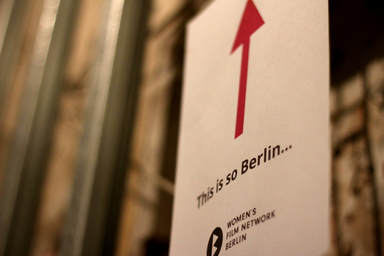 (photo: courtesy of Brace Bargo) (photo: courtesy of Brace Bargo) By Guest Contributor Brace Bargo Located in Berlin, Germany, Brace is interested in history, film and culture, and the way they resonate together. Having studied at University of Illinois at Chicago and Freie Unversität, he applies this background to find new ways to understand film that is relevant for critics and casual viewers alike. When not hidden behind the keyboard or movie screen, he dabbles in music, filmmaking and the hipsterest of craft beers. Rain beat down as the audience wandered in the cryptically-labelled Kreuzberg courtyard trying to find the theater. The sign had been spotted: Sputnik Kino, 5th floor. Wait. Five stories up? Yes, five stories up. But there’s an elevator, right? No. The prize at the end of this journey was a collection of short films made by female filmmakers, presented by the Women’s Film Network Berlin and the short film Meetup Shortcutz. In the entrance, one gazed up at the task before them: stairwell after stairwell framed by raw walls and hanging wires. Upon reaching the first set of stairs one was greeted with an uplifting sign “No pain, no film” shortly followed on the next staircase with “This is so Berlin…” (written in English, which is itself quite Berlin). Perhaps the trial by stairs was meant as a taste of the struggle and pain of women in the film industry? The fight to reach the top only to receive a condescending pat on the head, rejection, or platitude? Whatever the reason, the struggle is always worth the reward when it comes to promoting the representation of the underrepresented in the media landscape.  (photo: courtesy of Brace Bargo) (photo: courtesy of Brace Bargo) Women’s voices, and those of many other identities, are conspicuously inconspicuous in the production of film and television. Most can recall an actress, but it is a much greater challenge to recount the work of a renowned female director, producer or writer, positions which shape the stories to be told. The difficulty recalling a favorite female producer or director is due to the fact that there just are not that many. From all these influential roles, women make up no more than twenty-seven percent of the field, and are even more limited as executive producers, directors and writers.[1] One must assume that the numbers for LGBTQ and ethnic communities do not fare much better. What we lose from this exclusion is the ability to engage with a too-often ignored part of itself, that is, the groups and identities excised from the simplified concepts of “everyday” culture, but nonetheless constitute a part of who we are as individuals and society. Women are denied their voice and the expression of their individual worldview. No two people see things exactly the same way, but all have been influenced by their surroundings. The external too often determines the internal, as how one looks changes the way one is greeted, treated, raised, employed, included, excluded, and even the way one speaks or is allowed to speak. It is a diversified and distributed network of power and norm-production that builds the frame within which our freedom and individuality exist.[2] Is it not fair then, that all those affected should be seen, heard, and take part in the conversation? It is this void of the voiceless that is expanded through the exclusion of alternative perspectives from cinema and media and against which the Women’s Film Network Berlin positions itself. The WFNB “hosts meetups and events aimed to provide a space to inspire, empower, inform and collaborate.” And far from inciting revolution: “At the end of the day, most of us just want to make something.”[3] A space is thus provided for women filmmakers to collaborate and refine their work, and tools are shared to bring these perspectives to a wider audience. The Sputnik Kino, like all theaters, is a place where identities and ideas are produced and reproduced on the screen daily, and on this rainy Wednesday evening, newly refined voices were about to leave their mark. The evening consisted of four short films written and directed by female or female-identifying filmmakers: The Glasshouse by Gianna Arni, Win Win by Nina Walter, Löwe am Montag/Lion on Monday by Leni Wesselman, and Out of Frame by Sophie Linnenbaum. All of the films showcased great production value, witty and clever writing and clear sense of vision. The themes were familiar: loneliness, failed ambitions, complicated relationships and regret. One is tempted to ask, what is so female about these films? That, however, is precisely the wrong question. Contrary to the popular idea “men are from Mars, women are from Venus,” the concept of two distinct camps reduced down to their supposed core sexuality, all individuals have been shaped by similar social forces. Since the information we receive is filtered through a gendered lens, the internalization of this influence has individual effects; different perspectives on the same processes. These new takes on old themes come through in the works of the Berlin Female Filmmakers short film collection. The Glasshouse delves into failed fatherhood and reveals both a critique and expectation of masculinity through the lens of director Gianna Arni. Sophie Linnenbaum in Out of Frame explores not just feminist observations that women are seen and judged through the male gaze, but also the isolation of being the observer, the never seen, the camera itself.[4] Indeed, some of the films resonate with and reproduce Hollywood tropes as Löwe am Montag maintains the essentializing form of the eccentric girlfriend and the boyfriend that just can never understand. Win Win addresses the aspirations of women to achieve the beauty ideal, and uncritically replicates this narrative. Cliché, one could say, but so is Hollywood, because the cliché is what exists in everyone. It is not necessary that these films and other works of women tear down the system or address brand-new, specifically feminine things. Indeed, the limitation of female filmmakers to only talk about female things is already the reality, as so-called chick-flicks exemplify. It is significant that these filmmakers observed themes and feelings that affect them and thus touch on narratives that affect everyone, and through sharing their vision, they help clarify, and more importantly, take part in defining this ephemeral object we call culture. Women in film does not necessarily mean feminism in film. To limit women to feminist stories and ideologies serves to further isolate their work from the rest. The films this evening had a tendency to reproduce rather than resist the patriarchal narrative. All four films had male protagonists, male narrators and the agency to act was largely in male hands. Mothers were caregivers, women characters prioritized beauty and eccentricity was a female trait. Men and women existed as categories without question. One must remember that liberation is the freedom to choose to accept the status quo and to identify with whatever one wishes. The first step to an equal culture is telling the story from all sides and being part of the larger conversation, to have a platform from which to confront and construct what it means to be a woman, and to share this process with a larger audience. The WFNB takes a great first step in amplifying the voices of the underrepresented from the small screen to the big screen, and eventually letting them reverberate through the halls, down the stairs, and in the exposed structure itself (where, coincidentally, one could very easily build an elevator). [1] http://womenintvfilm.sdsu.edu/research/. [2] Michel Foucault, Discipline and Punish, 1975. [3] http://www.womenfilmberlin.com/. [4] Laura Mulvey, Narrative Cinema and Visual Pleasure, 1989. This post was originally published on Brace's blog. He graciously allowed us to post it on Femfilmfans in an edited form. To read Brace's original post in its entirety, please visit his blog at the link below: https://threadbaer.wordpress.com/2018/02/07/female-filmmakers-berlin-pt-1/
0 Comments
Leave a Reply. |
Archives
February 2020
Categories |


 RSS Feed
RSS Feed
